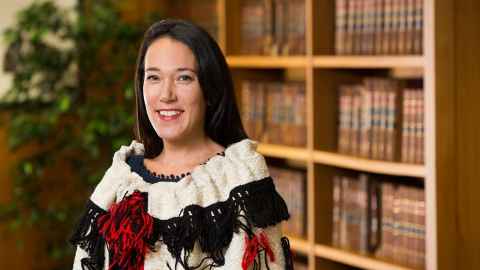What could a te Tiriti-based constitution look like?
22 November 2022
Leading minds on constitutional law and politics from across the country and around the world are collectively exploring how New Zealand’s constitution might be transformed.

Experts from around the world came together at the University of Auckland this week to discuss arguments and options for constitutional transformation to realise Māori rights within te Tiriti o Waitangi, He Whakaputanga and the UN Declaration on the Rights of Indigenous Peoples.
“On behalf of te Puna Rangahau o te Wai Ariki, our Aotearoa Centre for Indigenous Peoples and the Law, nau mai, haere mai,” said Auckland Law School academic Dr Claire Charters (Ngāti Whakaue, Tūwharetoa, Ngāpuhi, Tainui) as she greeted close to 400 people on the first day of the ground-breaking Constitutional Kōrero (Monday, 21 November).
“Here, we will ask ourselves what would a te Tiriti-based Aotearoa New Zealand constitution look like and how do we realise it,” said Dr Charters.
“Answering these questions will require us to think deeply about our vision for our nation and how to design unique constitutional structures that are right for us, our lands and our identity as a Pacific nation of Polynesian and settler whakapapa.
“We can be inspired by lessons from elsewhere.”

Renowned experts on Indigenous peoples and state and Indigenous constitutions, including from Chile, Mexico, Canada, the US, Vanuatu, Australia, Japan, the Philippines, Tanzania, Greenland, Peru, Sweden, and Norway, together with some of Aotearoa’s thought-leaders on tino rangatiratanga (Māori sovereignty) are attending the kōrero.
Over several panel discussions, they’re exploring ideas including different models for constitutional reform and design and asking whether a written constitution is desirable or whether an unwritten, more flexible constitution might better reflect the dynamic relationship between Māori, the Crown and the New Zealand nation.
On day one, the Hon Justice Joe Williams and Pou Whakatupu Mātauranga at Te Wānanga o Raukawa, Ani Mikaere, set the scene for the kōrero, touching on justifications for transformation as well as different methods to realise it.
Laureate Professor Emeritus Cheryl Saunders from Melbourne Law School and Auckland Law School Associate Professor Nicole Roughan discussed the merits and potential pitfalls of borrowing ideas for constitutional transformation from other countries and theoretical justifications for pluralism.
Other keynote speakers included Distinguished Professor S. James Anaya from the University of Colorado, University of Arizona Native Nations Institute Research Director Dr Miriam Jorgensen, human rights expert Victoria Tauli-Corpuz, University of Queensland Professor Emerita Jennifer Corrin and University of the South Pacific law lecturer Dr Morsen Mosses.
Day two of the conference (Tuesday, 22 November) was opened by the Minister of Foreign Affairs and Trade Hon Nanaia Mahuta. Meanwhile, on the final day more leading minds on constitutional law and politics from across the country and around the globe collectively explored how New Zealand’s constitution might be transformed.
Thanks to the Borrin Foundation and the Human Rights Commission for making the Constitutional Kōrero possible.
Learn more about the conference here.
Media contact
Sophie Boladeras | Media adviser
M: 022 4600 388
E: sophie.boladeras@auckland.ac.nz